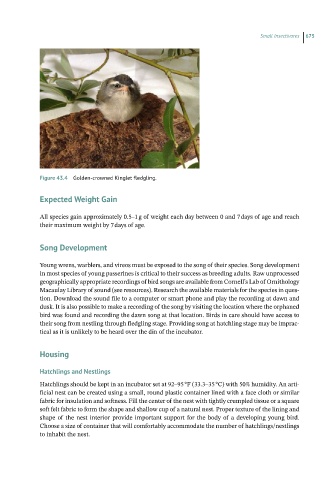Page 674 - Hand rearing birds second
P. 674
Small Insectivores 675
Figure 43.4 Golden-crowned Kinglet fledgling.
ExpectedWeightGain
All species gain approximately 0.5–1 g of weight each day between 0 and 7 days of age and reach
their maximum weight by 7 days of age.
Song Development
Young wrens, warblers, and vireos must be exposed to the song of their species. Song development
in most species of young passerines is critical to their success as breeding adults. Raw unprocessed
geographically appropriate recordings of bird songs are available from Cornell’s Lab of Ornithology
Macaulay Library of sound (see resources). Research the available materials for the species in ques-
tion. Download the sound file to a computer or smart phone and play the recording at dawn and
dusk. It is also possible to make a recording of the song by visiting the location where the orphaned
bird was found and recording the dawn song at that location. Birds in care should have access to
their song from nestling through fledgling stage. Providing song at hatchling stage may be imprac-
tical as it is unlikely to be heard over the din of the incubator.
Housing
Hatchlingsand Nestlings
Hatchlings should be kept in an incubator set at 92–95 °F (33.3–35 °C) with 50% humidity. An arti-
ficial nest can be created using a small, round plastic container lined with a face cloth or similar
fabric for insulation and softness. Fill the center of the nest with tightly crumpled tissue or a square
soft felt fabric to form the shape and shallow cup of a natural nest. Proper texture of the lining and
shape of the nest interior provide important support for the body of a developing young bird.
Choose a size of container that will comfortably accommodate the number of hatchlings/nestlings
to inhabit the nest.

